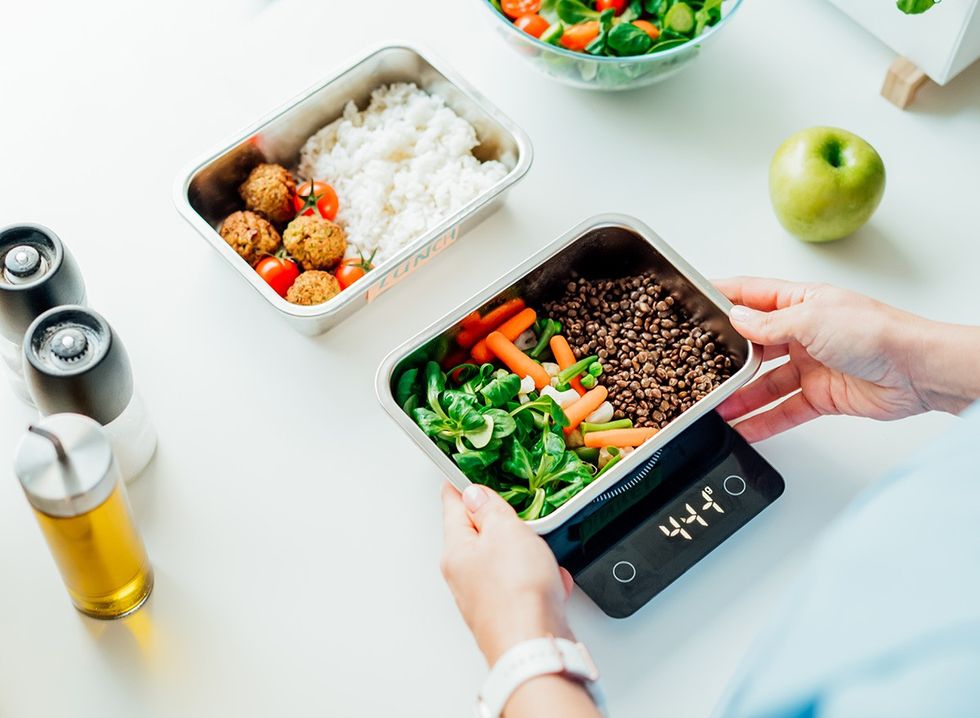Brenda Lizard is a weight loss influencer who goes by the TikTok handle @brenda.lizard. In two of the many viral videos discussing her massive and rapid weight loss — she lost 40 pounds in just under four months — she reveals a few simple tricks that helped. And, a few of them might surprise you.
1. Brenda Decided to Change Her Lifestyle After Learning She Had Pre-Diabetes
@brenda.lizard Replying to @evelynn How i lost weight 🙂 Comment if you need clarification or DM me on insta and I’ll respond to you quicker there #gymtok #greenscreenvideo #greenscreen
Brenda prefaces the video by confessing that she is not a professional. “This is just what I did and what worked for me,” she said. She also revealed that she “decided to change” her lifestyle for health reasons, namely after she got a breast reduction and discovered she had pre-diabetes during the blood work. “So obviously I had to make a change for my own health,” she said.
2. First, She Changed Her Diet

The “biggest thing” for Brenda was changing her diet, because after getting her breast reduction she couldn’t exercise for two months. “I couldn't lift anything over 15 pounds, so it was all my diet,” she said. Instead of going on a “specific diet like keto or whatever” she went on a calorie deficit, “which basically you're counting your calories.” She calculated how much she needed, inputting her age, weight, and height, and then figured out how many calories she would need to cut to lose one pound a week, which came out to 1,670 calories per day. For breakfast she ate overnight oats or an egg spinach omelet. “I love cottage cheese and cottage cheese is what's gotten me through a lot,” she added. For lunch she would eat tuna salad, chicken wraps, and “just regular chicken salads with a side of something.” She still ate out on occasion. “So if I were to go to Wingstop, I would still mess up some wings, but instead of getting regular fries, I'd get sweet potato fries. If I went to In-N-Out, I would still get a double double, but I'd get it lettuce wrapped,” she revealed. “I never felt miserable throughout this whole entire process just because I would eat what I wanted. And at home, I don't necessarily count my calories If I make my food at home, only if I'm going out to eat, that's when I do start counting my calories,” she added.
Related: The 13 Secrets for Building Powerful Legs
3. Second, She Started Doing Cardio

Once able to start doing cardio, she started seeing the most weight loss, “and don't think it's extreme cardio,” she said. “I've always been an early bird, so I've always woken up six in the morning to eight in the morning, the latest. And I would go get up, and then I would go on runs, jogs, I take my dog out. We bonded a lot throughout this entire process, and I would go on hikes.” A 2018 study published in the journal Obesity found a link between walking 10,000 steps a day and weight loss and weight management. Other studies published by the Journal of American Medical Association (JAMA) in JAMA Neurology and in JAMA Internal Medicine also linked walking 10,000 steps a day to less dementia and less cardiovascular disease overall, with less heart disease, less heart failure and fewer strokes.
4. Third, She Joined a Gym and Used the StairMaster

She also got a gym membership at LA Fitness, “and I just go there to use a StairMaster,” which she says “is a must.” Recently, the "25-7-2" StairMaster workout went viral, with people boasting about the weight loss benefits. It involves jumping on the stair-climbing machine, setting it to level 7, and climbing for 25 minutes. Does it actually work? "Any new stimulus will burn more calories at first, but your body will always adapt to whatever stimulus you're doing," Katie Kollath, ACE CPT and cofounder of Barpath Fitness, previously told our sister website Eat This, Not That! "So, if you want to continue to burn more calories after a couple of months doing this workout trend, you will either need to increase activity elsewhere or do the StairMaster workouts for longer."
Related: 10 Ways to Eat for Abs
5. And Fourth, She Started Lifting Weights
@brenda.lizard Replying to @Brenda DM me on insta or comment if you need clarification!!! #gymtok #weightloss
Once cleared by the doctor, she started lifting weights. And, for anyone who is starting to lift, she warns against putting too much emphasis on the numbers on the scale, as “muscles are heavier than fat.” To warm up, she would jog to the gym or go on the treadmill for ten minutes. She would also do more cardio – a little over a mile of walking, jogging, and sprinting – post lifting. Then, she would take a quick water break and “hit up” the StairMaster, her “favorite” workout. “I go on it for 15 minutes. I'd range from level four to six, sometimes seven,” she said. While first “scared” of the dumbbell area, she says she learned how to lift by watching tutorials on her phone or getting help from other people at the gym. “No shame at all. I didn't know what I was doing at first, and there's times that I still don't know what I'm doing, but I just go and I say YOLO, and I watch my little TikTok tutorials on how to do my form and stuff,” she concluded.
💪🔥Body Booster: Incorporating a StairMaster workout into your routine can help you lose weight. Just make sure to continue increasing intensity as time goes on.

















 alexx.fitt/TikTok
alexx.fitt/TikTok alexx.fitt/TikTok
alexx.fitt/TikTok alexxandra.fitt/Instagram
alexxandra.fitt/Instagram
 I'm a Nutritionist and These 9 High-Protein Snacks Keep My Clients Full While Losing 50 Pounds
I'm a Nutritionist and These 9 High-Protein Snacks Keep My Clients Full While Losing 50 Pounds
 Shutterstock
Shutterstock 2. Processed FoodsShutterstock
2. Processed FoodsShutterstock Shutterstock
Shutterstock Shutterstock/Prostock-studio
Shutterstock/Prostock-studio Shutterstock
Shutterstock Pro TipsShutterstock
Pro TipsShutterstock Shutterstock
Shutterstock Shutterstock
Shutterstock Shutterstock
Shutterstock Shutterstock
Shutterstock Don’t Drink as Much AlcoholShutterstock
Don’t Drink as Much AlcoholShutterstock Most Women on GLP-1s Are Making a Few Common MistakesShutterstock
Most Women on GLP-1s Are Making a Few Common MistakesShutterstock Soda and Sugary DrinksShutterstock
Soda and Sugary DrinksShutterstock Shutterstock
Shutterstock Eat BreakfastShutterstock
Eat BreakfastShutterstock And Improve Insulin SensitivityShutterstock
And Improve Insulin SensitivityShutterstock Belly Flab Strip Tip: Sugar and Fat Calories Leave Its Mark on Your BodyShutterstock
Belly Flab Strip Tip: Sugar and Fat Calories Leave Its Mark on Your BodyShutterstock Shutterstock
Shutterstock The Drugs Mimic the GLP-1 Hormone Naturally Produced by the BodyShutterstock
The Drugs Mimic the GLP-1 Hormone Naturally Produced by the BodyShutterstock 3. Deep-Fried ItemsShutterstock
3. Deep-Fried ItemsShutterstock